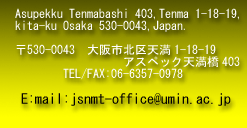  |
|
| The Japanese Society of Nuclear Medicine Technology | |||||
|
---2006:Seoul No.1 ---2006:Seoul No.2 ---2005:Istanbul ---2004
|
Participating in
Kansai Medical University Hirakata Hospital  
I attended the 9th Congress of the World Federation of Nuclear Medicine and Biology (WFNMB), which is convened once every four years, as it was recently held in November in Seoul, South Korea. I had two objectives in attending WFNMB this time. Firstly, I wanted to broaden my perspective by being exposed to the atmosphere of an international academic congress, which is different from those held in Japan, as I have had few opportunities to participate in conferences held overseas. Secondly, I took the liberty of qualifying for the International Exchange/Personnel Dispatching Program provided by the Japanese Society of Nuclear Medicine Technology (JSNMT) in order to justify making a fact-finding tour to WFNMB and made contact with nuclear medicine technicians in South Korea. This is because I am acting as the Chairman of the Execution Committee to convene the 27th Academic Congress of JSNMT, which is scheduled for July 14 and 15, 2007 in Japan. In connection with the second objective of my participation representing the Executive Committee for the 27th Academic Conference of JSNMT and because of the low cost of the trip to a neighboring country, I hoped to have as many executive committee members as possible attend with me. Then, I put together a 200,000 yen fund provided from the System, with 100,000 yen each given to Mr. Shuji Kawai (Osaka City General Center) and Mr. Hiroyuki Tsuima (Osaka City University Hospital), whose participation was determined as congress presenters by the Overseas Research Presentation Support Program of JSNMT. With such payment as the source of funds, the Executive Committee was represented by Mr. Shoji Horiuchi (Osaka City Kita Hospital), Mr. Hidehito Nagai (National Cardiovascular Center), Mr. Atsushi Imoto (Uji Hospital) and Ms. Yu Narumi (Yodogawa Christian Hospital). Although it wasn't very far to travel, total funds of 400,000 yen was not enough to pay for 7 members, who therefore covered the shortfall individually. In addition to seven members, we had Mr. Asaji Hirota, one of the research presenters dispatched by the above Support Program, join from Nippon Steel Hirohata Hospital and thus a delegation of 8 persons made the trip to Seoul (Fig. 1).  Fig.1 While the WFNMB Congress lasted for a week from October 22nd (Sunday) through the 27th (Friday), our group elected to make a trip of four days and three nights in light of the participants' work schedule and budget constraints. Our group arrived at Incheon International Airport at 11:30 a.m. on October 23rd Upon checking in to our hotel in Seoul, we went on to COEX, a congress site located in Gangnam-gu, which houses South Korea's largest general amusement center comprised of the Central City Air Terminal, ASEM Tower, the COEX Exhibition Hall, the Hyundai Department Store (Trade Center) and an Aquarium in the basement level. After registering for the Congress, we began making preparations for the group's assigned mission in South Korea, conducting public relations activities regarding the 27th JSNMT General Academic Congress. We tried to put up English posters that we had brought from Japan, but there were no display booths available for JSNMT to use. While our group was going back and forth in the display area, we ran into Chairman Manabu Ukita, to whom we explained the difficulty that we were facing and he suggested that we "ask the Japanese Society of Nuclear Medicine (JSNM) and have the posters put up in a corner of their booth. As a result, they willingly accepted our request and kindly put up two posters in the best location (Fig. 2).  Fig.2 Thereafter, we met Dr. Chang Ho Kim, the next chairman of the Korean Society of Nuclear Medicine Technology (KSNMT), who is concurrently serving as the publicity official for WFNMB. When Dr. Kim visited Fukuoka, Japan, to conduct public relations activities at the 26th JSNMT General Academic Congress, I met and became acquainted with him for the first time and he seemed to remember me. Upon showing him our posters, Dr. Kim kindly took the trouble to put up our posters in person at the KSNMT booth (Fig. 3). He also invited us to the Technologist Welcome Reception held later that evening.  Fig.3
 Fig.4
 Fig.5
 Fig.6 The total number of oral presentations was 324, while there were 767 display
presentations. The number of oral presentations from Japan numbered 26
and display presentations 96. The number of display presentations at this
Congress was twice as many as oral presentations. In the display hall,
we noticed that some of the posters were coming off the wall (unlike the
Japanese presentations). While wondering if WFNMB might be something like
a festival in many aspects, we moved on to the oral presentation hall,
where we actually found questions and answers to be actively exchanged.
What attracted our attention was that a presentation was being made on
SPECT/CT followed by PET/CT at the lecture session and SPECT/CT in twos
and threes even at the general lecture. The scale of the instrument display
hall was not very large, but there were many instruments and pieces of
equipment from Japanese manufacturers displayed and the displays themselves
were as good as at academic gatherings in Japan. |